Caulk or wood filler: choose the right one for every project
Ok, so caulk and wood filler may not seem like the most exciting thing to talk about, but if you want to make even the most basic upgrades to your home, you’re going to need to know about caulk and wood filler. What they are, what they do, and most importantly, what is the difference between the two.
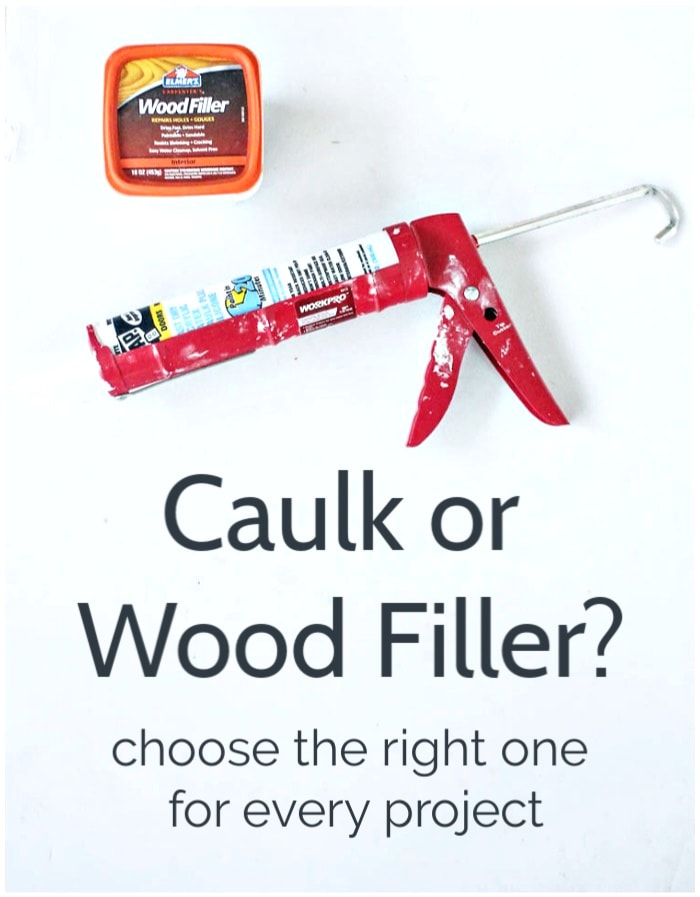
The first thing to know about both caulk and wood filler: they are magical things. Maybe a slight exaggeration, but seriously, they can turn something ugly and amateur-looking into something smooth and gorgeous.
Earlier this year, when I installed DIY board and batten in our bathroom, both caulk and wood filler helped make the whole project look amazingly professional.
Got trim that looks like a kindergartener installed it? Chances are caulk can save it.
Got a hand-me-down dresser with huge gouges in it? Wood filler can fix that.
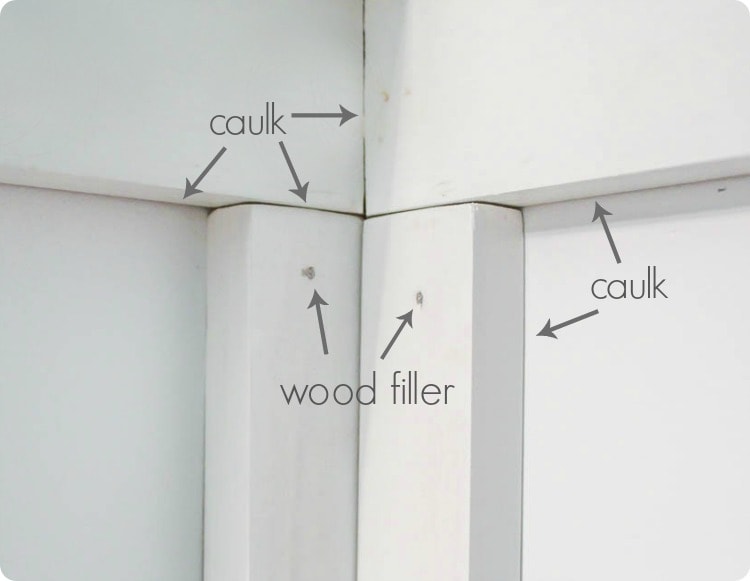
If you have any intentions of ever building, fixing, or simply maintaining anything in your home, caulk and wood filler are going to be your best friends.
The problem is it isn’t always so simple to know which one to use. They both fill gaps and holes, so it kind of seems like either one will get the job done. But use the wrong one and your project may end up looking even worse than before, so here are some super simple guidelines to follow.
This post contains affiliate links which means if you make a purchase after clicking a link I will earn a small commission but it won’t cost you a penny more. Click here to see my full disclosure policy.
Wood Filler
Wood filler (also called wood putty) is exactly what it sounds like – it fills holes in wood. It dries very hard, can be sanded smooth, and can be painted to blend in.
Some wood filler can also be stained to match the surrounding wood, though it can be pretty tricky to match the color. Wood filler typically comes in a beige color (similar to the color of unstained wood), but you can also buy white wood filler.
Some wood filler needs to be mixed with water, but most wood filler comes already mixed and ready to use. You can apply it with your finger or with a small putty knife if you prefer.
Personally, I really love wood filler because it is so easy to get a pristine finish. You don’t have to be meticulous when you apply wood filler, because you are going to be sanding it smooth anyway. Fast and easy – just the way I like it.
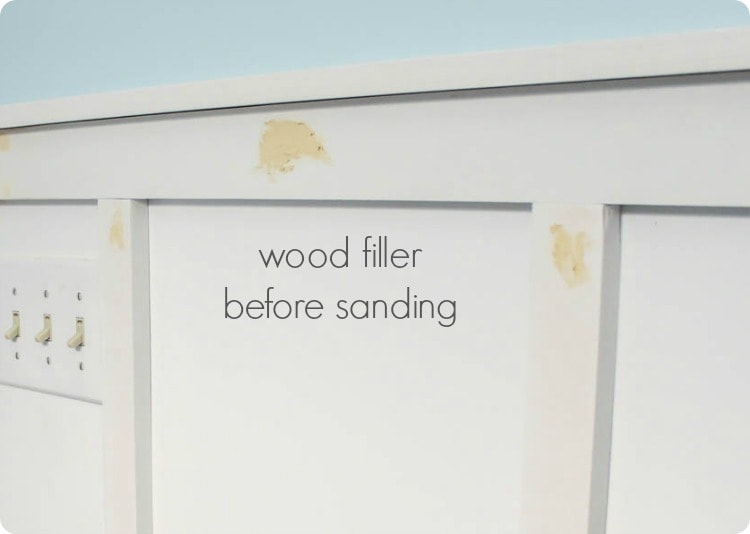
Wood filler works great for
- fixing holes and gouges in wood, including wood furniture
- filling nail holes
- filling outer corners of molding and trim
Caulk
Caulk is used to seal any gaps wherever two surfaces meet.
There are lots of types of caulk and they can be used for all kinds of purposes: creating an airtight seal around windows and doors, creating a water-proof seal around bathtubs and sinks, and filling in simple gaps around baseboards and other molding.
Caulk can be silicone or acrylic. Silicone caulk is waterproof and lasts longer without shrinking or cracking. But it can’t be painted.
Acrylic caulk is easy to use, easy to clean up, and can be painted to match the surrounding trim and walls. But it can become distorted over time so it isn’t a good choice for all applications.
Really, you don’t have to worry too much about all that though, because the different types of caulking are clearly labeled. The caulking choices at your local home improvement store will clearly say on the label if they are to be used for windows and doors, bathtubs, etc. and also whether or not they are paintable.
Keep in mind caulk needs to be applied very neatly because it can’t be sanded.
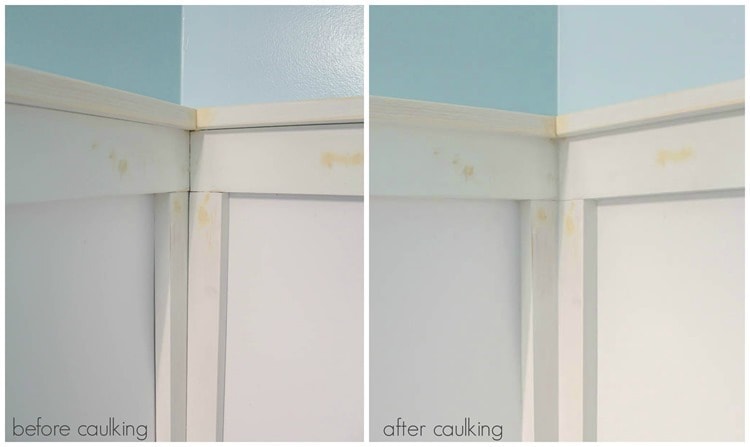
Caulk is great for
- filling small gaps and cracks around baseboards, crown molding, door and window frames, and other trim
- filling any inner corners of moldings
- sealing windows and skylights
- sealing around bathtubs, sinks, and other bathroom fixtures
- sealing around the edge of tile work
On the other hand, caulk is terrible for filling nail holes and other holes in wood because over time it will shrink and cause a divot.
And wood filler is a terrible choice for filling gaps in trim – it would take forever to apply and sand.
But either one in the right situation can be magical!
Check out the final results of my DIY board and batten. This was my first time doing anything like this, but after all was said and done, it looks amazing!
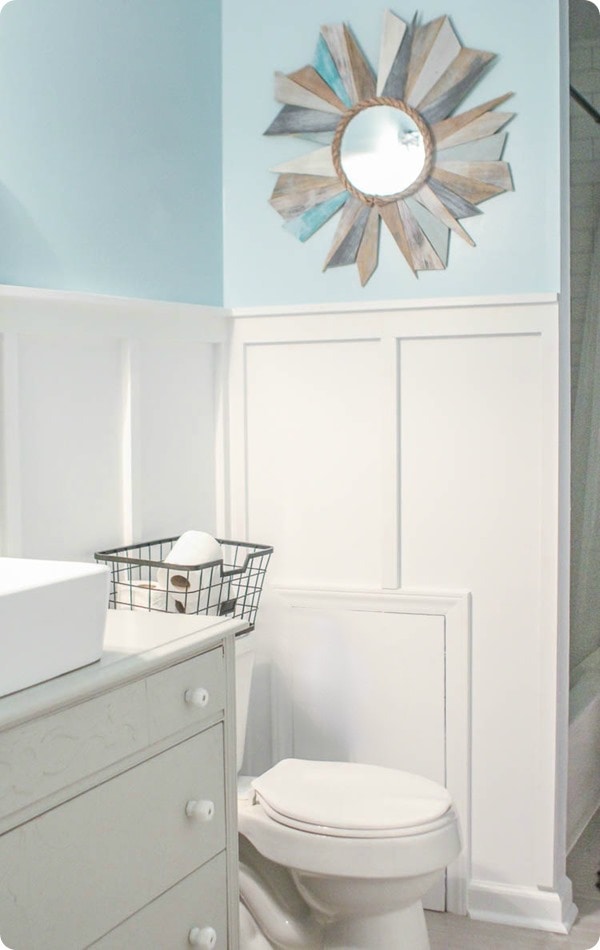
Here are a few more DIY posts I think you’ll find helpful:
- Do you Really Need Power Tools to DIY?
- The Best Paintbrushes for a Perfectly Smooth Paint Finish
- Everything You Need to Know about Primer


Thanks for sharing your insights. About to tackle my baseboards with nailholes and adjoining edges.
Good luck!
Thanks. Exactly what I needed.
Glad to help!
Just about to tackle window sill cracks! Caulk all the way!
Thank you for the advice.
Good luck!
This is the exact information I was looking for. Thank you!
I am so glad it was helpful!
Yes me too! What a wonderful page with easy to use information without all the mumble jumbo thank you!
So glad it is helpful!
Thanks! It helped a lot
I am so glad!
You are a life saver!! I’ve started building furniture, just for fun, and (of course) have those 2 pieces that are 1/8” to small to make a tight fit and after put the plastic wood filler in the crack (tons of it!!) I decided to look up caulking furniture & came across your page!! This information is great!! Love your work, too!! Thx!!
Thanks Melissa – I’m glad I could help. And how fun that you are building furniture! Enjoy the new hobby!
gosh….thank you for the clarification!!!
my brother (who actually knows almost everything….REALLY) told me caulk would suffice for filling screw holes in the porch rail, and i disagreed, saying i thought wood putty/filler was the correct stuff to use…..
omg, i won!!! hahaha
thanks again!!!
Haha, don’t you just love when you are right!
Great info!
Thank you!
Whew! Getting ready to fill holes and gaps in trim in my daughters bedroom and dont want it to look like amateurs did it. Thanks again!
You got this!
Ok i was told to use all purpose acrylic latex caulk plus silicone to make my diy cornhole boards niceand smooth. My wife just told me that caulk aint gonna work as a long term. So do i sand off caulk and use wood putty or can i just sand boards and start painting my boards???
I would agree caulk probably wasn’t the best choice. Unfortunately, caulk doesn’t sand well but can be scraped off with a putty knife. You may need to score it with a utility knife first. If it seems to be sticking well and doesn’t scrape off easily, I would just leave it and paint it. But if it comes off easily, it might be easier to deal with it now and prevent future problems. Good luck!
Unfortunately, I did not read this until AFTER I filled in nail holes, divots, and knots in the wood. The caulk is not perfectly smooth in some areas. In larger holes it is actually depressed from the surface. Should I go over these areas with filler? Try to remove the caulk?
I would probably try going over a couple of the depressions with wood filler and sanding smooth as a test. If the wood filler adheres well and the finish is smooth, you can do the rest the same way.
Great advice! Also, anytime you have glossy surfaces in need of filling, patching, or gluing, it’s always best to scratch or “scuff sand” the defect or pieces to be repaired so the filler/glue adheres, and not just pop off later. Sometimes, I actually drill small holes at different angles to help fillers/glue flow into & grab better. It can add strength to the fill. What’s the saying? “Things may have to get a little worse before they get better.” …and stronger.
Great tips! Thanks!
This is hands down one of the best posts I’ve ever seen about DIYing!!!
“Just add caulk!” Is our inside joke in the business because it has SO many uses! Even professionally! Interior, exterior, sealing and aesthetically. Don’t cheap out though, it may seem as though you’re being ripped off for a tube when it costs two or three times the 2.50$ tube you’d otherwise use but you get much better coverage and longevity out of the high quality stuff.
If you know anyone (contractor, tradesperson, developer, builder, etc) with an account at almost any construction related wholesalers (including paint, electrical and plumbing suppliers), have them order the stuff not sold in department stores and have them put it on their account (way cheaper too usually). We use White Lightning (harder to get in Canada but still manageable) available without issue in the States for silicone and caulk. If properly installed, it won’t crack for the life of the project it is going on!
Thanks for the tip!
Very helpful, but I still have a question about my project — new pine stairwell. I understand that I need to use wood filler over where the nails were “gunned” in. But there is a tiny gap between the edge of the step and the wall. Painted concrete block on one side and sheetrock on the other. Do I fill that with stainable wood filler before sanding/staining/sealing, or do I use caulk? Or? Thank you!
-Ruth
I would use caulk for this. You can use paintable caulk and caulk first. Or if the stairs are going to be white, you can also caulk after if you prefer.
I see other people say use wood filler in between the molding cracks instead of caulk. I am confused
I prefer to use caulk for this because wood filler tends to shrink over time and cause gaps to reopen. Most professionals also agree caulk works best.
This is a great explanation, thanks! I am doing a billy bookcase and want to seal the gaps with caulk for a built in look. My question is, when I paint over it (I’m using a deep orange/red colour) will it show as a different shade to the bookcases? And could I use spackling instead of the caulk?
I wouldn’t use spackling – it generally only works well for very small gaps. As far as painting, if you are painting red, using primer first is probably a good idea anyway and will also ensure there is no color difference. Primer is probably a good idea anyway because red paint tends to take a few more coats to get even coverage. If you tint your primer pink, it will cut down on the coats of paint you need. Good luck!